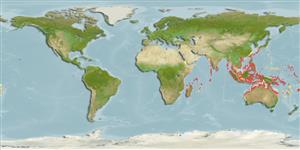>
Eupercaria/misc (Various families in series Eupercaria) >
Labridae (Wrasses) > Corinae
Etymology: Macropharyngodon: Greek, makros = great + Greek, pharyngx = pharynx + Greek,odous = teeth (Ref. 45335).
More on author: Randall.
Environment: milieu / climate zone / depth range / distribution range
Écologie
marin récifal; non migrateur; profondeur 2 - 30 m (Ref. 90102). Tropical
Indo-Pacific: Sri Lanka, western Australia, Indonesia and New Guinea.
Taille / Poids / Âge
Maturity: Lm ? range ? - ? cm
Max length : 13.0 cm TL mâle / non sexé; (Ref. 30874)
Rayons mous dorsaux (Total): 11; Rayons mous anaux: 11. Brown to greenish with pearly to metallic-green spots along scale rows (Ref. 48636). Females reddish anteriorly, shading to blackish posteriorly, with greenish yellow spots edged in blue and black (1 per scale) on body and similar spots and irregular bands on head. Males similar in colour to females, with no black humeral spot (Ref 9823).
Inhabits lagoon and sheltered seaward reefs, in areas with mixed sand, rubble, and coral to at least 30 m. Occurs singly or in small groups (Ref. 9710).
Life cycle and mating behavior
Maturité | Reproduction | Frai | Œufs | Fécondité | Larves
Oviparous, distinct pairing during breeding (Ref. 205).
Randall, J.E., 1978. A revision of the Indo-Pacific labrid fish genus Macropharyngodon, with descriptions of five new species. Bull. Mar. Sci. 28(4):742-770. (Ref. 2694)
Statut dans la liste rouge de l'IUCN (Ref. 130435)
Menace pour l'homme
Harmless
Utilisations par l'homme
Aquarium: Commercial
Plus d'informations
RéférencesAquacultureProfil d'aquacultureSouchesGénétiqueElectrophoresesHéritabilitéPathologiesTraitementNutrientsMass conversion
CollaborateursImagesStamps, Coins Misc.SonsCiguateraVitesseType de nageSurface branchialeOtolithesCerveauxVision
Outils
Articles particuliers
Télécharger en XML
Sources Internet
Estimates based on models
Preferred temperature (Ref.
123201): 25.2 - 29.2, mean 28.6 °C (based on 2494 cells).
Phylogenetic diversity index (Ref.
82804): PD
50 = 0.5002 [Uniqueness, from 0.5 = low to 2.0 = high].
Bayesian length-weight: a=0.00977 (0.00470 - 0.02030), b=3.07 (2.89 - 3.25), in cm total length, based on LWR estimates for this (Sub)family-body shape (Ref.
93245).
Niveau trophique (Ref.
69278): 3.5 ±0.4 se; based on size and trophs of closest relatives
Résilience (Ref.
120179): Haut, temps minimum de doublement de population inférieur à 15 mois (Preliminary K or Fecundity.).
Fishing Vulnerability (Ref.
59153): Low vulnerability (10 of 100).
Nutrients (Ref.
124155): Calcium = 94.4 [56.1, 164.7] mg/100g; Iron = 0.75 [0.43, 1.40] mg/100g; Protein = 18.5 [15.7, 20.7] %; Omega3 = 0.166 [0.104, 0.268] g/100g; Selenium = 22.6 [13.0, 42.0] μg/100g; VitaminA = 155 [48, 598] μg/100g; Zinc = 1.71 [1.15, 2.66] mg/100g (wet weight);
